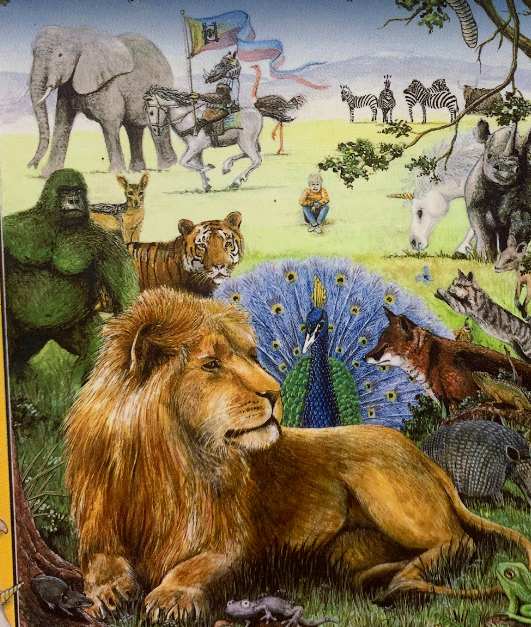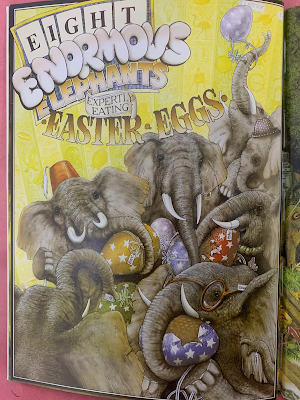Recent sync activity has centered around Animalia by Graeme Base, which is an alphabet book. I was thinking how funny it was to be taking an alphabet book so seriously, and then I remembered that I was well within Mormon tradition in so doing, given Joseph Smith's Grammar and Alphabet of the Egyptian Language. This is commonly referred to (by those few who do refer to it) as "the GAEL," which I guess makes the language therein described -- clearly "Egyptian" in name only -- GAELic.
"The Gael" is also the name of that tune from The Last of the Mohicans. Just in case it's not playing in your head already, here's a little help:
My interest in Animalia has been focused on the G and L pages -- two of the letters in GAEL -- both of which have some "Gaelic" themes. The L page includes a leprechaun, while the main subject of the G page is green gorillas. Green is the symbol of Ireland, and Punch cartoons used to portray the stereotypical Irishman as "Mr. G-O'Rilla." The Irish poet William Butler Yeats has recently been associated with Pharaoh's butler from Genesis, who dreamed of holding a cup and pressing grapes into it:
And Pharaoh's cup was in my hand: and I took the grapes, and pressed them into Pharaoh's cup, and I gave the cup into Pharaoh's hand (Gen. 40:11).
Here, from Animalia, is a green gorilla preparing to do just that:
I've just noticed for the first time that William Butler G-O'Rilla's grail is decorated with running greyhounds -- only they're not grey; they're gold. A golden dog running ties right in with Lassie Come Home on the L page:
Lassie is a stereotypically Scottish word, so there's another "Gaelic" link.
It occurred to me to look up gael on Eldamo. It's defined as "pale, glimmering" -- another link to Yeats, Claire, and The Song of Wandering Aengus, in which Aengus pursues a "glimmering girl." Another permutation of the same letters, laeg, is also Elvish and means, what else, "green."
The G and L pages encode the two keys. One of these, remember, is associated with gold, red, the sun, and the rose; the other, with silver, green, the moon, and the lily. Lions are associated with gold and the sun, and there is a key reference in the Lions' library in the form of a book by John Locke. Gorillas are associated with silver ("silverback"), and a gorilla is in a loose sense a "monkey" -- moon-key. The green "silverback" on the G page is complemented by the red "lobsterback" on the L page.
L and G also represent the square and compass. The square obviously resembles the letter L and appears as such in Mormon symbolism. Some forms of the capital G look like an arrow indicating circular motion, which is the function of the compass. (Transliterated into Greek, the mapping is reversed: Gamma is the square; Lambda, the compass.)
Doing an image search now to try to find a particularly arrow-like form of G, I found this, which for some reason also includes a lion named Lucas -- not the most natural choice for a page about the letter G!
But G and L are only two of the four letters in GAEL. What of the other two? Well, I don't have much to say about A at this point, but recent syncs have strongly suggested that I give the E page another gander. "Stink Gorilla More" included a photo of a little gorilla figurine my wife keeps on one of her bookshelves. The other day I was passing that shelf and noticed the gorilla's companions:
I first noticed the lion-gorilla juxtaposition, of course, but elephant is E, another component of GAEL. This trio of animals is also prominently featured on the cover of Animalia:
The E page of Animalia is kind of boring. Unlike G and L, which include dozens of different things beginning with those letters, E pretty much just has elephants and Easter eggs.
I mean, eggs are a Humpty Dumpty link, and he's been associated with the number eight (nice belt!), but that's about it.
Then I noticed that each of the eggs has a tiny name tag. The names are Emily, Elizabeth, Eric, Esmerelda (sic), Egbert, Ethel, Ernest, and what could be either Edward or Edwin. I guess these are the elephants' names. You can click the photo above to zoom in if you want to see the names for yourself.
The relevance of some of these is immediately obvious. William Wright has already written quite a bit about Elizabeth and Egbert. Eric is interesting because if you look back at the photo of the cover, an elephant (Eric?) is standing right next to a knight on horseback (a warthog knight, but still). Eric Knight is the author of Lassie Come-Home. The one that really got my attention, though, was the misspelled Esmerelda. William Wright recently posted about how the Elfstone in Tolkien's writings is a Green Stone. The name Esmeralda means "emerald" -- i.e., a green stone -- and here the spelling has been modified so as to include elda. Elda, as I suppose even the merest dabbler in things Tolkienian will be aware, means "elf."




























